Battle of the Granicus › Bayan I › Etruscan Pantheon » Origins and History
Articles and Definitions › Contents
- Battle of the Granicus › Origins
- Bayan I › Who Was
- Etruscan Pantheon › Origins
Ancient civilizations › Historical places, and their characters
Battle of the Granicus › Origins
Definition and Origins
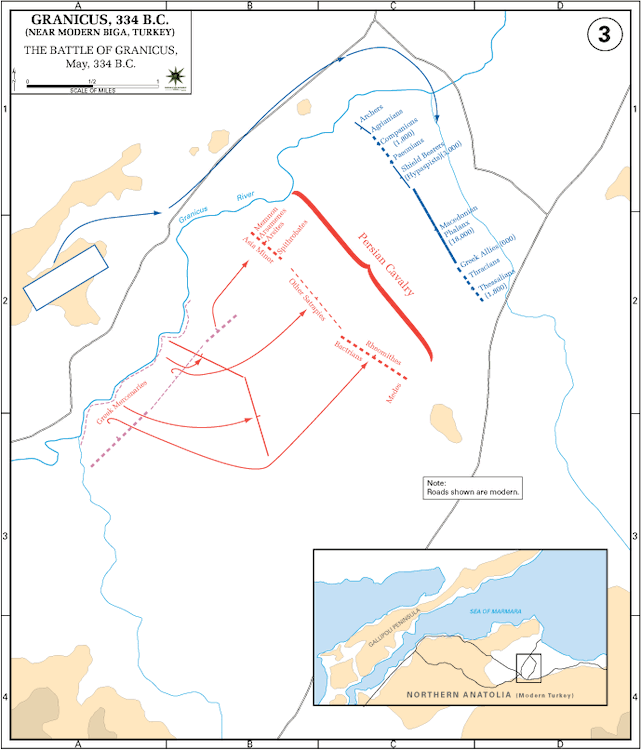
Alexander the Great crossed the Hellespont with his combined Macedonian and Greek forces and stepped upon the shores of Anatolia. His goal was simple: to defeat King Darius III, the last king of the Achaemenids, and conquer the vast Persian Empire. In May of 334 BCE he had his first opportunity when he faced the Persians on the banks of the River Granicus.
After the death of his father Phillip II of Macedonia, Alexander set his sights on the Persian Empire seeking revenge, or so he claimed, for the invasion of his homeland by Darius I and Xerxes decades before. Upon stabilizing rebellious conditions among the various Greek city -states, he crossed the Hellespont and travelled along the northern coast of Anatolia (present day Turkey ) avoiding the mountain ranges of the northern uplands to the site of ancient Troy. Little of him was known to the Persians and King Darius felt little or no inclination to meet him, believing, instead, his trusted commander, Memnon, and the local satraps could handle the young upstart. Besides, the newly appointed king was more concerned with possible rebellion and unrest among the local satraps.
In his The Life of Alexander the Great historian Plutarch discussed Alexander's trip to Troy where he honored Homer ’s hero Achilles. Plutarch wrote:
He passed the Hellespont, and at Troy sacrificed to Minerva, and honoured the memory of the heroes who were buried there, with solemn libations, especially Achilles, whose gravestone be anointed, and with his friends, as the ancient custom is, ran naked about his sepulcher, and crowned it with garlands, declaring how happy he esteemed him, in having while he lived so faithful a friend, and when he was dead, so famous a poet to proclaim his actions.
While Alexander and his men were at Troy, the Persians held a council of local satraps to discuss the arrival of the young Macedonian and possible strategies to defend against him. Memnon, a high-ranking Greek mercenary loyal to Darius, suggested applying a burned-earth policy -- to destroy crops, farms, and villages -- depriving Alexander of any possible provisions. The local satraps rejected the idea in part because Memnon was Greek but also because they did not want their lands destroyed. The Persians, of course, considered themselves far superior to the invading Greeks. The council decided to put the arriving Macedonians on the defensive by gathering their combined forces and wait for Alexander at the River Grancius. The Granicus was roughly sixty feet wide with both a fast current and steep embankments, providing, what they thought to be, an advantage for themselves.
THE BATTLE WOULD BEGIN IN THE AFTERNOON BUT WOULD LAST BARELY AN HOUR.
After receiving word from his scouts of the Persians' location at Granicus, Alexander advanced towards the river; he had come to realize that he must defeat the Persians to gain the necessary resources to continue on his quest of conquering Persia. As the Macedonian forces neared the river, Parmenion, one of Alexander's most loyal generals and commander of his left flank, advised Alexander they should wait until morning before attacking. Alexander replied, according to Plutarch, that it would “disgrace the Hellespont should he fear the Granicus.” The historian Arrian spoke of this encounter by saying that Alexander realized that the Persians did not fear him because they did not know him. Alexander rejected Parmenion's plea, the battle would begin that afternoon but would last barely an hour. Although numbers vary among the various ancient sources, modern accounts number the Persians at 10,000 cavalry and 5,000 Greek mercenary infantry. Alexander's forces numbered 13,000 infantry and 5,000 cavalry.
One unique and problematic situation for the Persians was the positioning of their cavalry on the banks of the Granicus; the Greek mercenary infantry -- 5,000 strong -- was placed behind them. Some historians believe this idea cost the Persians the battle. The Persian cavalry could neither move forward because of the river banks nor pull back because of the location of the infantry. In addition, the one weapon unique to the Persians, the scythed chariot, was almost useless on the muddy riverbank. Was this a tactical error or pure arrogance? Together with the lack of true leadership -- besides Memnon -- the battle was lost before it was begun.
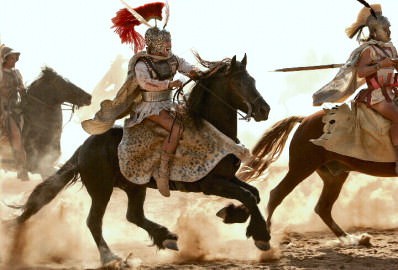
Alexander the Great in Combat
According to Arrian and other sources, Alexander made himself extremely conspicuous both by the “brightness of his arms” and the “respectful countenance of his staff.” He was also quite noticeable by the large white plume on his helmet. This conspicuousness did not escape the Persians whose major objective became to kill Alexander.
For a brief moment, both armies stood across from each other in silence. Alexander had lined his forces on the western banks of the river -- Parmenion commanded the left while Alexander (with his eight bodyguards), his Companion cavalry forces, and light troops stationed themselves on the far right. In the center of the traditional phalanx were the Thessalian cavalry and additional light troops. Alexander became the aggressor sending, from the center, Companion cavalry, lancers and light troops across the river first. The Persians responded with a hail of arrows and javelins. They were intent upon attacking the Macedonians in the water where the footing was slippery and difficult. Memnon himself led the Persian centre. As more Persians joined the attack against the Macedonian centre, attention was drawn away from Alexander. Although causing considerable damage to the attacking centre, the Persian weaponry did not match well against the Macedonians – light javelins versus fifteen foot lances.
Amid the sound of trumpets, Alexander and his men plunged into the water and up the opposing bank diagonally. Arrian wrote:
He himself led the right wing with sounding of trumpets, and the men raising the war -cry to Enyallus, He entered the ford, keeping his line always extended obliquely in the direction in which the stream turned itself aside, in order that the Persians might not fall upon him as he was emerging from the water with his men in column, but that he himself might, as far as practicable, encounter them with a broad line.
Upon arriving on the opposite bank of the river, the fight turned to a hand-to-hand confrontation. Although suffering a number of casualties, Alexander began to gain the advantage, and many of the Persians began to retreat. Throughout the battle, however, the Greek mercenary infantry remained in its position and did not move.
As Alexander rose from the waters of the Granicus, he noticed Mithridates, Darius's son-in-law, riding with a squadron of cavalry -- detached from the main Persian forces. Alexander attacked, slashing Mithridates across the face. Rhoesaces, a Persian satrap commander, noticed the attack upon Mithridates and raised his sword at Alexander, slicing off part of his plume and cracking his helmet. Alexander quickly ran him through. Spithridates, another Persian commander, raised his own weapon to attack Alexander but Cleitus the Black attacked him first, severing Spithridates's arm, saving Alexander's life. With the loss of a number of their leaders, the Persians became disorganized and with morale destroyed retreated.
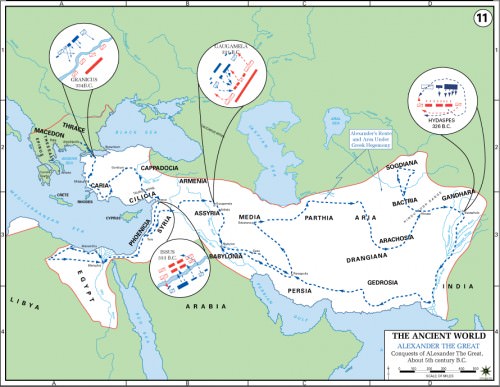
Map of Alexander the Great's Conquests
As the Persians fell back, Alexander, instead of pursuing the retreating Persians, turned his attention to the Greek mercenaries who, in turn, pleaded for mercy. Parmenion with the Thessalians encircled to the left of the Greeks while Alexander and his Companions positioned themselves to the right. Plutarch spoke of this encounter saying:
The mercenary Greeks, who, making a stand upon a rising ground, desired quarter, which Alexander, guided rather by passion than judgment refused to grant, and charging them himself first, had his horse (not Bucephalus ) killed under him. And this obstinacy of his to cut off these experienced desperate men cost him the lives of more of his own soldiers than all the battle before, besides those who were wounded.
Of the five thousand Greek mercenaries only two thousand survived, and they were sent to Macedonia to work the mines; the rest were slaughtered. Why did Alexander ignore the pleas of the mercenaries? Some believe he wanted to make a point for their taking Persian money while others say it was mostly anger and the near death experience that provoked him.
The spoils of war -- gold and rich cloth -- were sent home to Alexander's mother. To honor all who had died in battle Alexander buried both Greek and Persians alike (although the Persians normally burned their dead). According to adjusted modern accounts, the Persians lost ten to twenty percent of their forces and two-thirds of their commanders. Sources concerning Alexander are varied -- twenty-five to thirty Companions -- possibly one hundred twenty in total. Back home, statues honoring the twenty-five fallen Companions were erected at the sanctuary of Zeus at Dium near Mount Olympus. Three-hundred suits of Persian armour were sent home to Athens to remind the Greeks that Granicus were only one step in the war of revenge against the Persians.
After Granicus there was little resistance against Alexander and his forces. Soon, however, he would meet the King of Persia himself. In November of 333 BCE, Alexander and Darius would face each other at Issus.
Bayan I › Who Was
Definition and Origins

Bayan I (reigned 562/565-602 CE) was a king of the Avars, a confederation of heterogeneous people who migrated from the region of Mongolia, north of China, in 552 CE and came in contact with the Eastern Roman Empire in c.557 CE. Bayan I is considered the greatest king of the Avars for his military and political skills. He not only protected his people from the Gokturks, who pursued them from Mongolia after the fall of the Rouran Empire (known as the Rouran Khaganate) in the east, but he led them in a series of successful campaigns to defeat the Gepids of Pannonia, out-witted the Lombard king, Alboin, for control of the land, and challenged the supremacy of the Eastern Roman Empire. He founded the Avar Empire in the region of Pannonia, establishing his capital at the same spot that Attila the Hun had claimed as his own, and expanded that empire to encompass territory far beyond the original borders of the Pannonia they'd first arrived in. After Bayan I's death in 602 CE, the Avar Empire began to decline until it was finally conquered by the Franks in 796 CE, and the Avars ceased to exist as a distinct cultural and political entity.
BAYAN I & THE EASTERN EMPIRE
Bayan I first enters history with the migration of the Avars to the region of the Pontic Grass Steppe (an area corresponding to modern-day Ukraine, Russia, Kazakhstan) from Central Asia after the fall of the Rouran Empire. They were pursued by their enemies the Gokturks, who had toppled the supremacy of the Rourans in Mongolia and, as refugees, they were seeking a secure homeland they could settle and then defend. The historian Erik Hildinger describes Bayan's initial rise to power following the Avar's migration: "Shortly thereafter, in 565, Bayan ascended the Avar throne as Kaghan, or Great Khan. The Avars were the first to use this term, which would persist thereafter among the steppe peoples. Bayan was the greatest of their leaders" (76).
LIKE ATTILA, BAYAN'S COMMANDING PERSONALITY AND MILITARY BRILLIANCE WOULD NOT LIVE ON IN HIS SONS.
The historian HH Howorth states how, "The Avars were at this time led by a chief whom, if we knew more of, we should probably compare with Attila and Genghis Khan. His name was Bayan" (732). Bayan I is the first recorded king of the Avars and, like Attila, was the leader who unified and empowered his people. He raised the Avars from a band of refugees fleeing their oppressor to the dominant people of the region of Pannonia.
Regarding the origin of the Avars and their flight to the west, historian Peter Heather writes:
[The Avars] were the next major wave of originally nomadic horse warriors, after the Huns, to sweep off the Great Eurasian Steppe and build an empire in central Europe. Thankfully, we know rather more about them than about the Huns. The Avars spoke a Turkic language and had previously starred as the dominant force behind a major nomadic confederation on the fringes of China. In the earlier sixth century they had lost this position to a rival force, the so-called Western Turks [Gokturks], and arrived on the outskirts of Europe as political refugees, announcing themselves with an embassy that appeared at Justinian's court in 558 (401).
Although, as Heather claims, "we know more about [the Avars] than about the Huns", we know considerably less about Bayan I than Attila. After leading his people to the west, he almost immediately made contact with the emperor of the Eastern (or Byzantine) Empire. Justinian I (482-565 CE) agreed to hire them to fight against other tribes in the region as mercenaries and sent them on their way. The Avars ruthlessly massacred the enemies of Justinian I and expected that their relationship with the empire would continue but, should it not, tried to find a region they could settle in.
Although they were now employed by the powerful Byzantine Empire, they still needed their own homeland where they could feel secure from the pursuing Turks. Bayan I tried to lead his people south of the Danube River but was prevented by the Romans. He then led the Avars north but encountered resistance from the Franks under their king Sigebert I. They continued as nomads in the service of Rome until the death of Justinian in 565 CE. His successor, Justin II (c. 520-578 CE), canceled their contract and, when the Avar embassy asked for permission to cross the southern Danube, it was denied. They again sought to break through to the north but were repelled by Sigebert's army. Bayan I then turned his attention to Pannonia or, according to other sources, was invited to go there by Justin II to displace the Gepids.
BAYAN I & ALBOIN
The Lombards under Alboin were already in Pannonia in conflict with the Gepids who controlled most of the region. As with the Avars, sources conflict on whether the Lombards migrated to Pannonia on their own or were invited by the empire to drive out the Gepids. Bayan I wanted to take the capital city of Sirmium but did not know the region and needed the help of those better acquainted with it. He allied himself with Alboin and the Lombards and, in 567 CE, the two armies joined to crush the Gepids between them. Bayan I had already negotiated the terms of the alliance with Alboin: if they should win, the Avars would be given the Gepid lands, wealth, and people as slaves and the Lombards could continue to live unmolested in the region.Alboin most likely agreed to these unequal terms because Bayan I threatened him with conquest if he refused. This remains speculation, however, and it is not known why Alboin chose to accept the poor terms of the alliance.
The armies met in battle some distance from Sirmium, and the Gepids, under their king Cunimund, were defeated. Sources differ on what happened in the aftermath: according to some accounts, Bayan I killed Cunimund and had his skull turned into a wine cup - which he then presented to Alboin as a comrade in arms while, according others, Alboin killed Cunimund and made his skull into a cup which he then wore on his belt. Whomever it was that killed the Gepid king, his skull would later contribute to Alboin's death.
The armies of the Avars and Lombards marched on Sirmium, but the Gepids had already called for help from the Eastern Empire, agreeing to surrender the city to them in exchange for assistance; by the time Bayan I and Alboin reached Sirmium, it was heavily defended and they were driven back. Since they had not prepared themselves for an extended siege, the armies withdrew.

East Roman Empire, 6th century CE
THE RISE OF THE AVAR EMPIRE
Although Sirmium remained untaken, the Avars now controlled most of Pannonia and the Lombards found that the deal they had brokered earlier was a poor one. Alboin tried to form an alliance with the Gepids against the Avars by marrying Cunnimund's daughter Rosamund whom he had taken after the battle. It was now too late, though, as the Avars were simply too powerful to contest. In 568 CE, Alboin led his people out of Pannonia to Italy where, in 572 CE, he would be assassinated in a plot hatched by his wife to avenge her father. According to Paul the Deacon, Alboin's murder was the result of his drunken insistence that his wife drink from her father's skull.
With the Lombards gone, and the Gepids defeated, Bayan I then set about building his empire on the plains of Pannonia. That there seems to have been a core "Avar" ethnicity among the larger Avar confederation is seen in some of Bayan I's military decisions and decrees. The historian and scholar Denis Sinor writes:
The ethnic composition of the Avar state was not homogeneous. Bayan was followed by 10,000 Kutrighur warrior subjects already at the time of the conquest of the Gepids. In 568 he sent them to invade Dalmatia, arguing that casualties they may suffer while fighting against the Byzantines would not hurt the Avars themselves (222).
Under Bayan I's leadership, the Avars expanded across Pannonia in every direction and, through conquest, he enlarged his empire. A number of Slavic people had followed the Avars into Pannonia and these were now subjects of Avar rule and seemed to be treated with the same lack of regard accorded the Kutrighur soldiers. Bayan I oversaw the selection of the Avar base of operations in their new homeland. Historian Erik Hildinger comments on this, writing :
The Avars established their headquarters near Attila's old capital of a hundred years before and fortified it. It was known as The Ring. Now well established in Pannonia, Bayan fought the Franks of Sigebert again and defeated them in 570. A dozen years later Bayan attacked Byzantine territory and seized the city of Sirmium on the Sava River. He followed this with further campaigns against the Byzantines, the Avars taking Singidunum (Belgrade) and ravaging Moesia until they were defeated near Adrianople in 587. To the Byzantines, it must have seemed like a reprise of the Hunnic aggression of the fifth century (76).
AVAR CONQUEST
With Sirmium now taken, and operating efficiently from The Ring, Bayan I continued his conquests. Christoph Baumer writes how Bayan I drove his armies into the Balkans and demanded tribute from the Eastern Empire for peace and then, "together with the beaten Slavs, whom they abused as a kind of `cannon fodder', the invaded Greece in the 580's" (Volume II, 208).They operated in warfare with tactics similar to those used by the Huns a century before. Like the Huns, the Avars were expert horsemen. Baumer notes that, "The iron stirrup came to Europe only with the invading Avars in the second half of the sixth century." The stirrup "enabled riding in a squatting or almost standing position, which improved the rider's mobility, but also increased the impact of an attacking cavalry" (Volume I, 86). The stirrup greatly enhanced the already formidable Avar cavalry and made them the most feared and invincible mounted military force since the Huns. Baumer writes:
In his famous military handbook Strategikon, the Byzantine emperor Maurice (reigned 582-602) aptly described the battle style of the Avars, whom he compared to the Huns, as follows: `they prefer battles fought at long range, ambushes, encircling their adversaries, simulated retreats and sudden returns, and wedge-shaped formations...When they make their enemies take to flight, they are not content, as the Persians and the Romans, and other peoples, with pursuing them a reasonable distance and plundering their goods, but they do not let up at all until they have achieved the complete destruction of their enemies...If the battle turns out well, do not be hasty in pursuing the enemy or behave carelessly. For this nation [the steppe nomads] does not, as other do, give up the struggle when worsened in the first battle. But until their strength gives out, they try all sorts of ways to assail their enemies (Volume I, 265-267).
Justin II had begun a war against the Sassanids in 572 CE and, with imperial forces drawn to the east, Bayan I invaded further into Byzantine territories. He demanded higher and even higher tribute and defeated the imperial armies sent against him. It was not until 592 CE, with the conclusion of the empire's war with the Sassanids, that the emperor Maurice was able to send an army of adequate force against Bayan I. The Avars were driven from the Balkans and back into Pannonia by the imperial troops under the general Priscus, almost to their capital. The Avars would most likely have been destroyed en masse were it not for the insurrection in Constantinople known as Phocas' Rebellion in 602 CE.
At this same time, a plague broke out in the Balkans and swept across the surrounding regions. It is likely that Bayan I was one of the many victims of the disease. The historian HH Howorth, esq, writing in the Journal of Royal Asiatic Society of Great Britain and Ireland, notes:
We do not read again of Bayan, and it would appear that he died about this time, perhaps from the pestilence already named. It is not impossible that it was that pestilence, and the loss of their great leader, which made it possible for Priscus to win his victories so easily...The Avars never again recovered the vast power which they exercised under Bayan, who must be classed among the most successful of generals and the most powerful of rulers (777).
Bayan I was succeeded by his son who attempted to carry on his father's empire. In 626 CE he led a campaign against Constantinople, allied with the Sassanids, in a land and sea attack. The formidable defenses of the Theodosian Walls (built under the reign of Theodosius II, 408-450) repelled the land attack while the Byzantine fleet defeated the naval assault, sinking many of the Avar ships. The campaign was a complete failure and the surviving Avars returned home to Pannonia. As Howorth notes, the Avars would never again wield the kind of military and political power they had under the leadership of Bayan I. Like Attila, his commanding personality and military brilliance would not live on in his sons. After 630 CE the Avar Empire began to decline and was finally conquered by Charlemagne of the Franks in 796 CE with relative ease. In essence, the Avar empire began and ended with Bayan I.
Etruscan Pantheon › Origins
Ancient Civilizations
The religion of the Etruscans included a myriad of gods, goddesses, and minor divine beings, some of which were indigenous and some were imported, especially from Greece, and then given their own particular Etruscan attributes and myths. Temples and sanctuaries were dedicated to them, and these figures frequently appeared in Etruscan art in the form of pottery decoration, tomb wall paintings, sculpture, and engravings on such everyday objects as bronze mirrors. As no complete texts written by the Etruscans survive and only short inscriptions are available to us, then the information regarding each deity can be very limited, sometimes only to a name on a single votive offering. Below is a summary in alphabetical order of the most important figures in the Etruscan religion about which we have the most information. Alternative names and spellings are indicated in brackets.

Tin
AITA
Was the god of the Underworld in mythology but not the subject of a cult (see Calu). His consort was Persipnei, and the pair appears on tomb wall paintings, Aita wearing a wolf's cap and Phersipnei with snakes in her hair. Turms acted as his messenger.
ALPAN
A winged spirit symbolic of harmony. Perhaps a Lasa, she was the servant of Turan.
APLU (APULU)
A foreign import associated with the Delphic oracle and, therefore, Apollo. He is often associated with Suri. He was thought to live on Mt. Soracte near Veii and had a sanctuary dedicated to him at Gravisca, the port of Tarquinia. He is depicted in art with a wolf's cap or, as with the Greek Apollo, a bow and lyre. A life-size terracotta figure of him survives from the Portonaccio Temple at Veii. He is the brother of Aritimi and Fufluns.
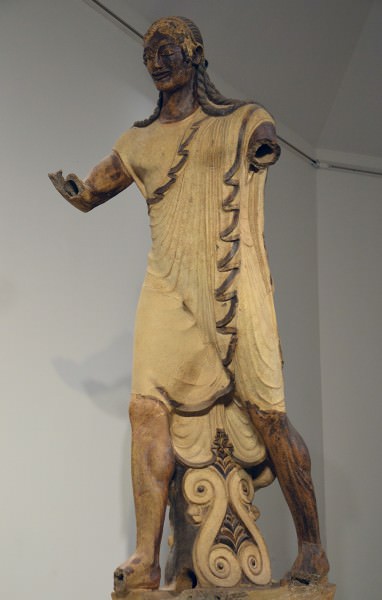
Apollo of Veii
ARITIMI (ARTUMES)
The huntress goddess based on the Greek Artemis but probably much older. Regarded as a mistress of animals, she was most associated with wolves and thought to protect human assemblies. She is the sister of Aplu.
ATHRPA
The goddess of fate. She sometimes has wings and drives a nail into a wall, symbolic of the irreversibility of fate.
ATUNIS (ATUNE)
The handsome youth beloved by Turan, the goddess of love. Equated with Adonis and especially worshipped at Gravisca, Tarquinia's harbour. He had a summer festival held in his honour and was an especially popular subject on engraved bronze mirrors.
CALU
The god of the Underworld who does not appear in art. In his place, Aita is depicted.
CATHA (CAVTHA)
Possibly the daughter of the Sun and referred to in inscriptions only as 'daughter.' A cult at Pyrgi, the port of Cerveteri, worshipped her along with Suri. She has an underworld aspect and a connection with family cults.
CEL
The Earth goddess often referred to in inscriptions as 'Mother Earth' (Cel Ati). She had a son, Celsclan, a Giant.
CHARU (CHARUN)
A demon of death similar to Charon, the ferryman of the Greek Underworld, but portrayed instead carrying a hammer and guarding the Underworld's gates. He is a fearful figure and sometimes has pointed animal ears, an eagle's beak, green skin, wings, and holds snakes.
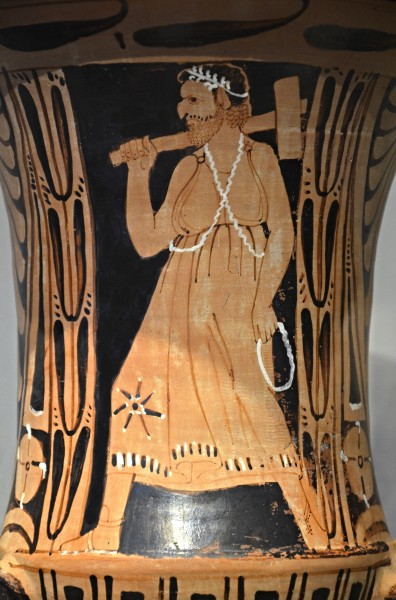
Etruscan Red-Figure Krater with Charun
CULSANS
A double-faced god of gates ( culsu in Etruscan) usually portrayed as a youth.
CULSU
A female demon who was guardian to the gate of the Underworld. Depicted wearing boots and carrying a torch and perhaps a key.
DII CONSENTES
12 advisors to the gods, or specifically to Tin, they had a reputation for being without pity.
FUFLUNS
The Etruscan name for Dionysos, god of wine, and like his Greek counterpart, he is often accompanied by satyrs and maenads. His mystery cult promised rebirth. He is the brother of Aplu and was sometimes referred to as Pacha. He is associated with ivy.
HERCLE
The Etruscan name for the Greek hero Hercules, but he appears more like the Phoenician Melqart in art and was always considered a god (and not a man who became immortal). Sanctuaries were dedicated to him and his associated oracles across Etruria.
LARAN
The Etruscan god of war whose consort is Turan, the goddess of love. He is depicted with or without a beard, usually wearing a cuirass and helmet, and carrying a lance.
LARES
Guardian of crossroads and travellers.
LASA
One or more handmaidens of Turan, the goddess of love. Considered to have a role in fate, they are sometimes depicted in art with wings and carrying a scroll.
MENERVA (MENRVA)
An important goddess but of uncertain name as Menerva derives from the Latin Minerva. Important temples dedicated to her include the Portonaccio Temple at Veii and the Pratica di Mare at Lavinium. Like the Greek Athena, she had a martial aspect and carried a spear but was also linked to education, especially of children. She had a major festival held in her honour each March.
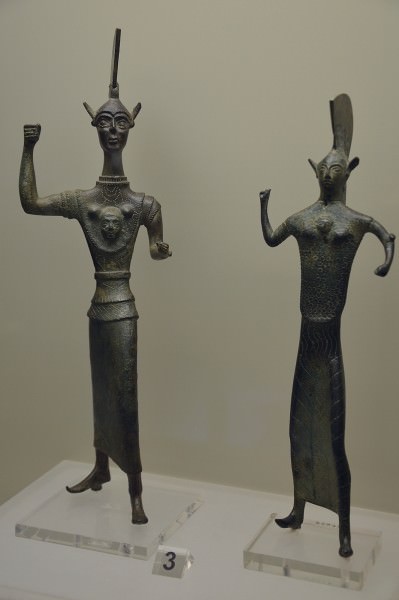
Etruscan Votive Statuettes of Menerva (Athena)
NETHUNS
The god of the sea who, like the Greek Poseidon, is portrayed with a beard and trident.
NORTIA
A goddess linked with Menerva and possibly fate. She had a temple dedicated to her at Volsinii ( Orvieto ). A ritual at her temples was to annually hammer a nail into the building to fix the fates for that year. Later, the custom was used to see off plagues and disasters.
NOVENSILES
Nine gods of lightning whose strikes were thought to indicate future events depending on their location.
SELVANS (SILVANUS)
A god of forests, pastures, and boundaries, frequently mentioned in inscriptions on votive offerings. He was thought to have powers in the Underworld. The single known depiction of him has him as a youth in boots and wearing a hat made of a boar's head.
SETHLANS
The god of fire and metal, equivalent to Hephaistos /Vulcan.

Temple Platform, Vulci
TAGES
The grandson of Tin, who miraculously appeared as a wise infant in a field one day near Tarquinia when it was being ploughed. He revealed to humanity the secrets of religious rites and set territorial boundaries. This information formed a large part of the Etrusca Disciplina texts, which priests studied and consulted.
THANR (THANUR)
A birth goddess and protector of children who was especially popular at Chiusi and Cerveteri.
THESAN
The goddess of Dawn who frequently received votive offerings at temple sites, especially at Pyrgi, the port of Cerveteri.
TINAS CLENAR
Castur and Pultuce, the twin sons of the god Tin, equivalent to the Dioscuri or Castor & Pollux. In the Tomba del Letto Funebre at Tarquinia, they are depicted wearing pointed hats wreathed in laurel.
TIN (TINIA/TINA)
The highest god in the Etruscan pantheon. Like his Greek/ Roman equivalent Zeus / Jupiter, he carries a thunderbolt. His consort was Uni. His role in human affairs was limited, and he concerned himself more with keeping peace amongst the gods.One area he was concerned with was the protection of boundaries, and in some temple sites, he has an underworld connection. He is depicted either as bearded or a beardless youth.
TIVR (TIUR)
Goddess of the Moon.
TURAN
The goddess of love, peace, and harmony, after whom the Etruscan equivalent of the month of July was named ( Traneus ) when her major festivals were held. Depicted sometimes with wings and in the company of Atunis, her son was Turnu ( Eros ), and her servants are Lasa.
TURMS
The herald of the gods and equivalent to Hermes / Mercury. He acted as an intermediary between the upper world and the Underworld, between humans and the gods, and between the gods themselves. He seems not to have been the subject of any cult and appears only as a figure in mythology.
TURNU
The winged youth who is the son of Turan and equivalent to the Greek Eros.
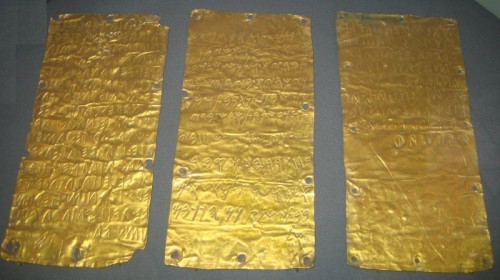
Etruscan & Phoenician Inscriptions
UNI
The consort of Tin and equivalent of Hera with also a connection with Astarte as indicated by the gold inscription plaques found at Pyrgi which are written in both Etruscan and Phoenician script. There is a martial element to her character, and she, like Hera, is the enemy of Hercle/Hercules. Votive inscriptions often pair her with Aplu.
USIL
The Etruscan Sun god. He was a popular figure in art, appearing on mirrors and terracotta roof decorations, typically with a halo of sunbeams.
VANTH
Un demonio femenino asociado con la muerte y el Inframundo. A veces tiene alas y sostiene serpientes o, como guía en el Inframundo, lleva una antorcha.
VELTHA (VELTUNE / VOLTUMNA)
De sexo incierto, pero asociado con la vegetación y, a veces, la guerra. Quizás incluso el dios etrusco nacional.
LICENSE
Article based on information obtained from these sources:with permission from the Website Ancient History Encyclopedia
Content is available under License Creative Commons: Attribution-NonCommercial-ShareAlike 3.0 Unported. CC-BY-NC-SA License